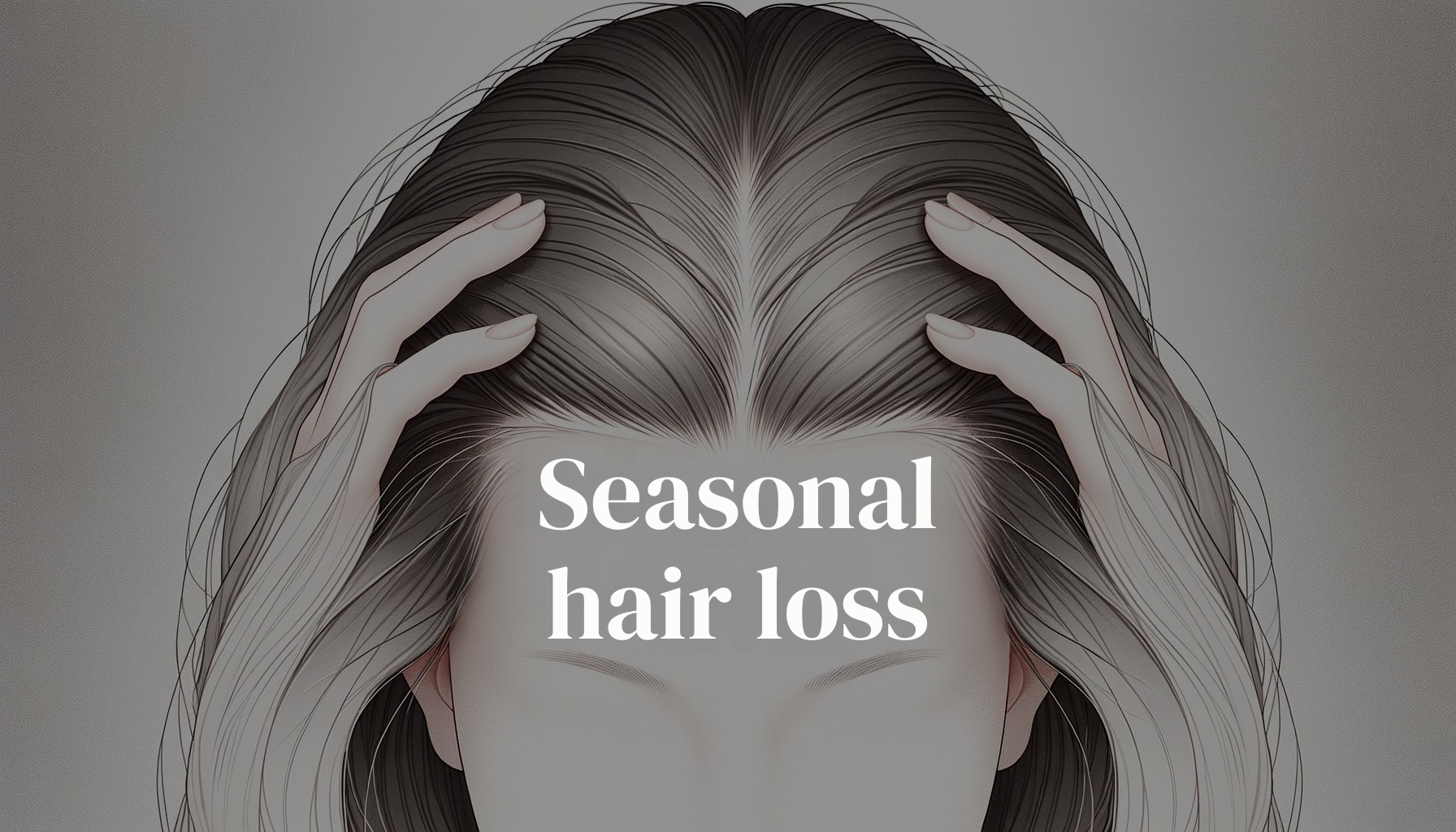
Article content
- Hair loss in autumn and spring – seasonal hair loss
- Similar posts
Seasonal hair loss, a phenomenon many of us may have noticed without realising its cyclical nature. It’s a normal part of the hair growth cycle, but it can make you uncomfortable. Especially if you don’t know that something like seasonal hair loss exists.
Facts
- Seasonal hair loss manifests itself in spring and autumn
- Increased hair loss is most common in February-April and August-September
- It’s a normal physiological reaction and the hair will grow back
- If the hair does not grow back or is thinner than before, it may be a form of alopecia or chronic telogen effluvium.
Why does hair fall out more in spring and autumn?
Seasonal hair loss refers to increased hair loss at certain times of the year, most commonly in the fall and spring. Typically, we see more hair loss in the fall than in the spring. Just as animals shed their fur, we shed our hair. This is one type of telogen effluvium, a condition of excessive hair loss due to various stressors (anything that triggers a reaction in the body, not just what we commonly refer to as stress). Seasonal hair loss is regular, cyclical and normal. But that doesn’t mean that nothing can be done about it.
Aging and its manifestations are also normal, but many people undergo various aesthetic procedures to eliminate the effects of aging. Even with seasonal hair loss, there are methods to promote hair growth and minimize the effects of this phenomenon.
What causes seasonal hair loss?
Exactly what causes seasonal shedding is unknown, but there are several generally accepted theories. However, they all agree that it is most likely a reaction to changes in sunlight intensity and day length. To understand this properly, it is important to know the stages of hair growth.
Human hair goes through a growth cycle that consists of three phases:
- Anagen phase (growth phase), which lasts approximately 2-6 years
- Catagen phase (transition phase), which lasts 2-3 weeks
- Telogen phase (resting phase) during which hair falls out, lasting approximately 2-5 months
- And then a new hair grows out of the hair follicle in the anagen phase. And this cycle repeats as long as the follicle is active.
Scientific findings on seasonal hair loss
Hair loss in spring and autumn is characterized by a prolonged telogen phase of hair growth. Instead of hair falling out within the standard 2-6 months, it takes longer. This will increase the number of hairs in the telogen phase on the scalp. And then all of a sudden, hair starts falling out in greater numbers than normal in a shorter time interval than normal. Particularly for people with long or curly hair, the changes in the number of hairs falling out are very noticeable (not that more hairs are falling out, but a long or curly hair falling out is more visible on the floor than a short straight hair).
According to the studies that have looked at seasonal hair loss, the critical months are July to October (with most of the patients studied reporting an August-September range) for the autumn cycle. For the spring cycle, the critical months were February to April, with the majority of patients surveyed reporting a lower volume of hair loss than for the fall cycle.
How to distinguish seasonal hair loss from hair diseases?
Seasonal shedding is characterized by temporary increased hair losswhich is usually noticeable when combing or washing the hair. You simply have more hair on your comb or brush than usual. Seasonal shedding is diffuse and affects the entire scalp. However, bald patches do not form. Patients may notice greater thinning of corners, sometimes even footpaths. This is temporary with seasonal hair loss and these areas will regrow.
If the walkway and corners don’t get overgrown, or the undercoat is thinner than before, there may be a more serious problem such as chronic telogen effluvium or some form of alopecia.
So, if the increased shedding persists for a longer period of time or is localized to certain areas, take it up with a doctor specializing in hair loss treatment who will tell you if it is classic seasonal hair loss or a more serious problem.
Coping with seasonal hair loss in autumn and spring
Mesotherapy
Mesotherapy is the injection of a solution enriched with vitamins and minerals into the scalp. Hair mesotherapy can be compared to dietary supplements, except that it is targeted application. This ensures that all the important nutrients to support hair growth get to where they really belong, i.e. to the hair follicles, so that the hair stays longer in the anagen phase.
This is the difference to dietary supplements in tablets, where the body decides where it will use them best and most efficiently. Learn more about mesotherapy in this article.
Plasmatherapy
Plasmatherapy works by regenerating and nourishing the scalp and stimulating inactive hair follicles into an active growth phase. While this does not create new hair follicles, it does strengthen existing ones. And by activating the inactive follicles, new hair growth will occur, leading to thicker and fuller hair.
A small amount of blood is drawn from the patient , from which platelet-rich plasma is separated and then injected into the scalp. Learn more about plasmatherapy in this article.
Diet and dietary supplements
A well-balanced diet rich in vitamins and minerals can promote hair health. Iron and vitamin D are particularly important for maintaining healthy hair growth. And others such as omega 3, zinc, folic acid and others can also help. But that doesn’t mean you should start ordering supplements right away. In my experience, I’m skeptical about them. If you are deficient in certain vitamins and minerals, supplements are a great option. But if you are not deficient, their effect will be minimal. So, before you decide to take them, get a blood test to see if you really need them. And whether it is not easier to adjust the diet.
Proper lifestyle
You must have heard it a thousand times. Get enough sleep, eat well, drink water, move around, don’t stress, go out in the sun, don’t smoke and don’t drink too much alcohol… Yes, this applies in general to anything related to our body.
Conclusion
Seasonal hair loss in autumn and spring may frighten us, but it is a normal physiological response to the change of seasons. Some people lose more hair at this time, some less, but everyone loses hair. Of course, if you have long hair, you probably notice hair fall more than if you have hedgehog hair. That’s why more women than men come to my clinic with this problem.
I have good experience with mesotherapy (which I personally use to alleviate the effects of seasonal hair loss). If hair loss persists for a long time, or if hair only falls out in certain areas of the head, it may be a manifestation of a hair disease, whether androgenetic alopecia or or alopecia areata. In that case, make an appointment with a doctor who specializes in hair treatment. The sooner you address the problem, the easier the remedy will be.




